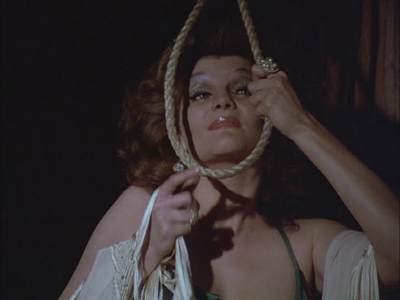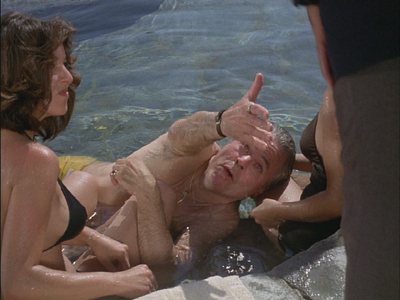 BUY IT AT AMAZON: CLICK HERE!
BUY IT AT AMAZON: CLICK HERE!
STUDIO: Universal
MSRP: $39.98 RATED: NR
RUNNING TIME: Approx. 15 hrs
SPECIAL FEATURES: None
When CSI
first hit the air, I remember the pitches my friends would make to me in their
evangelical fervor for the show. "It’s like Sherlock Holmes," they
would tell me. "The clues come out of nowhere!" I, being a young
snob, argued that the appeal of Sherlock Holmes wasn’t that the clues were
unexpected, but that they were assembled in a fashion that the reader hadn’t
predicted. I still prefer that method of mystery storytelling; it’s both more
credible and more rewarding.
The
writers of
of mysteries. When the show works, it’s television drama at its most Sherlock
Holmes; when it misfires, it’s more like CSI: 70s, but with a charismatic
lead.
The Show
Jack
Klugman plays the title character, a gruff, brilliant medical examiner with
only the minimum amount of respect for authority.
character, a mix of your wise grandfather and his dirty old neighbor. At some
point previous to the show’s chronology,
practice, but for a number of reasons he abandoned that practice to serve the
coroner’s office as chief medical examiner. Primary among those reasons is that
wanted to help people.

"Lighten up, Mr. Quincy! Ho ho ho!"
The
coroner’s office doesn’t seem, immediately, like the kind of place one would go
if one wished to help people. The people one is exposed to are usually beyond
all help. The way
couldn’t be better positioned if he was mayor. A medical examiner’s job, as we
are told by Quincy’s deeply put-upon superiors, is to examine a body, perform
an autopsy if necessary, determine cause of death, and sign a death certificate
naming that cause.
is something more along these lines: examine body, become suspicious, perform
illicit private investigation, become deeply
suspicious, implicate public figure in murder, be yelled at, become paranoid,
and, finally, be vindicated.
There is
far more variety to the plots than that, of course. One thing that
its daring choice of plot material. On these discs are stories featuring harsh
political commentary, moral responsibility, brutal emotional abuse, child
pornography, and others. It’s an impressive and progressive collection of
mysteries, featuring a number of topics that are often shied away from even in
our modern shows. Without fail, these daring episodes are the ones that I
mentioned above, the ones that hit on all cylinders.

Quincy meets the fetish scene.
But for
every compelling episode, there’s one that’s no deeper than a Y-incision.
of fatal food poisoning;
run-of-the-mill corruption in the office of the mayor;
clichéd, and rely entirely on Klugman to keep them afloat. Fortunately, Klugman
is equal to the task and provides a point of interest in otherwise mediocre
episodes.
A healthy
dose of disbelief-suspension is required for all of the episodes, the good and
the mediocre.
office, more concerned with getting to the truth in each situation than are his
superiors. It helps if you watch the seasons in chronological order. In the
first episode
by the detective in charge of the particular investigation, and then when
right, there are no repercussions. Future episodes, for the most part, dispense
with explicitly stating that nothing negative happens to
detective work on public time. The first episode does a nice job of addressing
the disbelief of the audience and then tossing it away. In this reviewers
opinion, it’s a scenario easier to swallow than the science fiction tools
employed by investigators in modern shows.
All of
recurring theme in the show: social obedience is good, bureaucracy is bad,
especially in the medical profession. The villains of each episode are a wide
variety of despicable and immoral characters, but the real antagonists are
Asten (John S. Ragin), and police lieutenant Frank Monahan (Garry Walberg). It’s
these two men who invariably act as foils for
truth. Both antagonists are sketched very broadly, making the overall
commentary heavy-handed, which is surprising considering the sophistication
with which other social issues are approached.
Back on
the structural level of the show, very few of the episodes are whodunits. In
the first episode, for example, the killer is shown in the very first shot. I
admire this deliberate removal of tension, and it transforms the show into more
of a whydunit, and the why always has
a more interesting answer than the who.
Klugman
is supported by a capable cast including Val Bisoglio as Danny, the owner of
Robert Ito as
is Lynette Mettey as
provides the best interplay. Lee and Quincy have an odd relationship, where
both claim that neither have any responsibilities to the other — kind of an
open relationship, but with the requisite doses of jealousy and hesitant
devotion. Sadly, Mettey left the show before season 2 and was replaced by a far
less interesting and less charismatic love interest.

NO KILL I
I was
born a bit too late to have an emotional attachment to
fact), but I can easily see how those who grew up with him would be glad to get
ahold of this three-disc set. Klugman is a pleasure to watch, especially when
he’s all fired up with indignant passion. The episodes are kind of
hit-and-miss, but they do represent a show trying to find its footing, and get
progressively more assured.
show with literary qualities. There are engaging mysteries on the surface and,
from time to time, subtext that rewards a deeper viewing.
7.6 out of 10
The Look
A simple
fullscreen presentation with a clear transfer. The editing is occasionally
rough, sudden transitions that reminded me of reel swaps in the theater. Also,
the stock footage used for establishing shots, and for externals at the
occasional airport, is grainy and poorly balanced.
There
have been complaints circulating the Internet about heavy pixelization in
certain episodes spread across the three discs. This is apparently a production
error; the set I reviewed had no such problems, but if you do encounter them,
an exchange at your retailer ought to set you up with a properly functioning
set.
7.7 out of 10

In the dark ages, this man would have been killed
before he reached age five.
The Noise
There’s
not much to say about the set, here. It’s mixed at Dolby 2.0 mono, no different
from its original airing. The music is the standard strings-and-brass fare of
70s drama. I have to poke fun at the season 2 opening sequence; the music is so
alarmingly inappropriate for the show, implying that you’re about to watch
at a birthday party.
7.4 out of 10
The Goodies
Nothing
other than French, English, and Spanish subtitles. I would have enjoyed even a
bit of text, some production notes.
0.0 out of 10

Yet another way in which Quincy revolutionized television.
The Artwork
It’s a
little unnerving that
the viewer rather than at what I’m sure is an insanely interesting slide in his
hands. The marketing folks also felt it was necessary to blazing "The Original Crime Scene Investigator"
right under the title for people, like me, who weren’t aware of
think it’s kind of funny that they picked the shade of green that they chose;
it’s a Matrix-esque (or Apple II-esque) color, the sort of green that suggests
technological sophistication. It clashes somewhat with the clunky microscope
positioned in front of
6.6 out of 10
The
quality of the DVD presentation doesn’t contribute enough to affect the score
given for the show. It’s quite a good show, but do keep in mind that there are
no extras, and for that I’m going to ding it a few tenths of a point.
Overall 7.2 out of 10